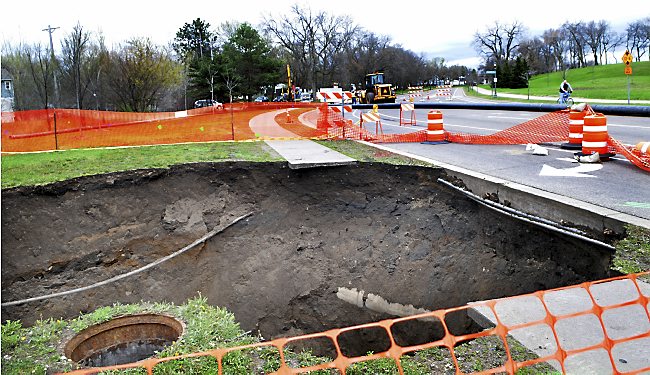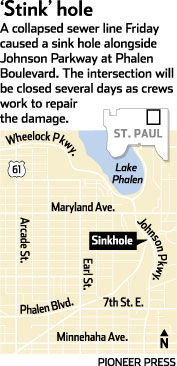
"It's hard to get here," said the 22-year-old vendor at the Moon's Kitchen food stand, whose commute was interrupted by detours around a gaping sinkhole that opened up overnight north of the popular weekend destination.
A sewer line collapsed at Johnson Parkway and Phalen Boulevard about 2 a.m. Friday, creating a crater about 25-feet deep alongside the road and forcing traffic to reroute around the major intersection.
Johnson Parkway is the only north-south through-street between Earl Street and White Bear Avenue and a major gateway to Maryland Avenue, which runs east-west through St. Paul's East Side. Emergency contract crews hired by the Metropolitan Council Environmental Services said the detours will likely be in place for four days or more.
"This is a big one; there's no question about it," said St. Paul City Council member Dan Bostrom, who spent the day touring the neighborhood with Public Works Department workers trying to figure out how best to deal with the traffic backups.
No one was hurt in the collapse, and the Met Council -- the Twin Cities regional planning agency -- said residents do not need to worry about boiling their water as a safety precaution or about sewage backing up into their homes.
"The drinking water supply is unaffected; the sewer system is unaffected," said spokesman Tim O'Donnell, who estimated the sinkhole was about 25 feet across.
Wastewater continued to flow through the 54-inch sewer line at a normal clip, according to a meter downstream from the intersection.
The sewer pipe, which was installed in 1989, carries about 12 million gallons of sewage daily from as far north as Forest Lake to the Metropolitan Wastewater Treatment Plant on the east side of the Mississippi River, across from Holman Field, St. Paul's downtown airport. The Met Council sewer line serves as a receptor for the city's local sewer pipes, which continue to collect sewage as normal, O'Donnell said.
He said it was too soon to say what caused the sinkhole, the first sewer-related street collapse he could recall in about a decade.
"It's more than likely natural corrosion of the concrete sewer," he said. "A large-scale collapse of the sewer surface is quite rare. We typically don't have sinkholes associated with sewer problems."
Heavy spring rains probably didn't help. It's more than likely, O'Donnell said, that the surface of the sewer pipe had caved in but the bottom half remains intact. To drain water while the repairs are made, wastewater will be pumped downstream through temporary piping, running several hundred yards north and south along Phalen Boulevard.
"It'll probably take several days to get this repaired," O'Donnell said.
Road crews were detouring nonlocal travel west to Arcade Avenue, east to White Bear Avenue, north to Maryland Avenue or south to Seventh Street.
Bostrom said many northbound Johnson Parkway drivers trying to reach Maryland Avenue Friday were turning east onto Magnolia Avenue and then north on Barclay Street.
The intersection at Barclay and Maryland is controlled by a stop sign, "and it's at the top of a hill, visibility is limited," he said. "It's just a recipe for disaster."
Because traffic was backing up for blocks on Barclay, he encouraged drivers to take Magnolia Avenue to Hazelwood Street, a block east, where they can reach Maryland from a traffic signal.
"We're going to have to ban parking in certain areas and close certain roads," Bostrom predicted.
At Hmong Village, the effect on sales was being felt Friday afternoon. Lucky Lee, the 23-year-old owner of the K Pho food stand, said business was down about 30 percent.
"We were wondering what was going on because yesterday was fine," he said. "Let's hope for the best."




Comment: See also this heat map for 2014 to date.